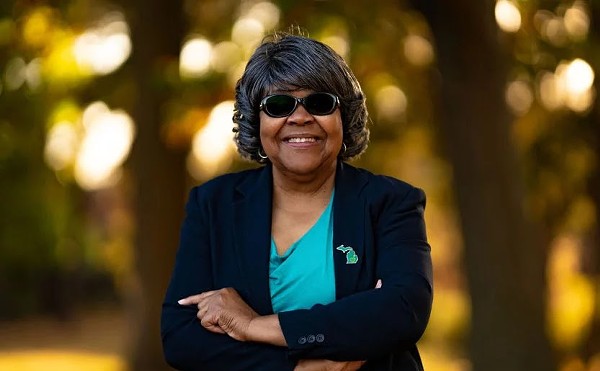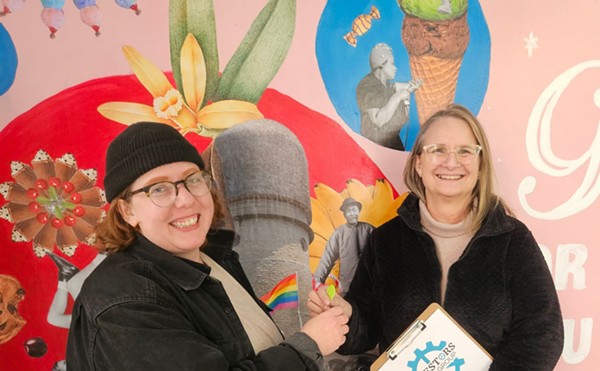Chris and Jim Burnett sit at the bar at the Detroit Beer Co. on Broadway Street in downtown Detroit. The Mount Clemens couple has been to the microbrewery a handful of times since it opened in September. They discovered it during baseball season when looking for a place to grab a bite and a beer near Comerica Park. Though the Tigers are done for the year, the Burnetts still patronize the place; they had a day off last week and drove 20 minutes from home to have lunch among an eclectic crowd of construction workers, businessmen and young folks in leather jackets. The bar is about half-full on this chilly weekday afternoon. But on weekends, the place is often hopping.
Broadway Street merchants have struggled for decades to draw people to the downtown strip. But with the recent openings of the Detroit Beer Co. and other popular businesses, the area is beginning to boom.
“We are loving every minute of it,” says Mike Simmons, who owns Simmons & Clark Jewelry, which his grandfather founded in 1925. Simmons is considering staying open later in the evening because there’s so much new foot traffic.
“It’s coming alive,” Mayor Kwame Kilpatrick says of Broadway Street.
But Kilpatrick doesn’t take full credit for the area’s resurgence. He says the groundwork was laid by previous administrations.
“No way did Kwame Kilpatrick do this alone,” the mayor says. “We’re just taking it to a new level.”
Kilpatrick says former Mayors Coleman Young and Dennis Archer laid the foundation for refurbishing downtown. But Kilpatrick is now shepherding the Lower Woodward Improvement Program. By Super Bowl XL, which will come to Ford Field in February 2006, Kilpatrick hopes to see a thriving, clean downtown from Jefferson to Grand Circus Park.
The city has specifically focused on three main drags — Woodward Avenue, Washington Boulevard and Broadway Street.
The goal is to create 1,000 new lofts and 50 new businesses in the area, as well as new streetscapes, says Greg Garland, executive vice president of the Detroit Economic Growth Corporation (DEGC), which is in charge of the Lower Woodward Improvement Program. Public and private money is funding the massive project, he says.
“We are trying to scrape together money from anywhere we can,” says Garland.
Some longtime business owners never expected to see Broadway Street bustle with activity during their lifetime. They attribute the rebirth to the attention city officials have given the area in recent years.
“I’m very excited that we are finally getting a concerted effort,” says Pepper Martin, who has owned The Broadway, a clothing store, and City Slicker shoes on Randolph Street for about 25 years.
In the past, the city wasn’t supportive of small businesses, says Martin.
“City participation has been hot and cold,” he says. “Going back to 25 years ago, it was kind of fend for yourself.”
But business at Martin’s stores has steadily improved in the past decade.
“I think we have had straight increases for every year,” he says.
Martin says businesses owners, the city and business associations are working together to improve the area.
“A lot of things were in place and this administration helped move it forward,” says Linda Bade, president of Detroit Downtown Inc., a business association that works with city officials and other groups to improve downtown.
“Broadway is the next area to take off,” she says.
Where to park?
It was the downtown’s recent turnaround that compelled Mike Plesz and his partners to open Detroit Beer Co.
“When you are growing as a business, you go in areas just as they take off,” says Plesz, who opened the Royal Oak Brewery as that city began to explode about eight years ago.
Plesz and his partners opened the Detroit branch two months ago, moving into the basement and ground floor of a five-story building. The 33-year-old entrepreneur and his partners purchased the 1903 building last year and have restored it to its original glory. Offices and a residential loft occupy the top three floors.
Plesz also co-owns the Rochester Mills Beer Co. But the Detroit Beer Co. does 75 percent more lunch business than his other properties, he says. He expects business will continue to increase as downtown develops.
“I think it’s only going to get better,” says Plesz.
The brewery and Small Plates, a popular restaurant that opened last year on Broadway, have created a fair amount of foot traffic. Adjacent neighborhoods also have helped bring people to the strip.
“We are the gateway between Foxtown and Greektown,” says Simmons, whose jewelry store is one of the oldest businesses on Broadway. “We are in the middle of everything.”
The 78-year-old jewelry business has weathered some tough times. For decades, Simmons, who took over the business from his father, remained hopeful that the downtown would see a renaissance. Now he’s sure it’s finally occurring.
“There is light at the end of the tunnel for the first time in 30 years,” he says.
With the crowds comes the need for more parking.
“At night it’s impossible,” says Simmons of parking availability.
But it’s not altogether unwelcome.
“I don’t mind parking problems. That means there are people here,” he says.
To help accommodate the crowds, the city plans to allow parking along curbs where it wasn’t allowed before. It recently added a handful of free one-hour spots across from Small Plates and the Detroit Beer Co.
The Detroit Opera House, which also sits on Broadway, plans to open its new parking garage by Super Bowl XL. The current one has about 625 spaces; the new one will have 650, as well as additional retail space on the ground floor, says Brett Batterson, chief operating officer of the Detroit Opera House.
This summer the Detroit Opera House, home to the Michigan Opera Theatre, also hopes to begin construction on its Center for Arts and Learning, which will include a retail store, research library, theater, dance studio, classrooms and other amenities, says Batterson.
The Motor City Paint Co., which opened in 2001, is housed in the first floor of the current Opera House garage.
To make the area business-friendly, the city has allowed “relaxed” parking zones in front of some stores, says Terrance Hall, who co-owns the paint store. Hall says parking enforcers are not to ticket cars parked in front of his store, though some still do.
Facelifts
All these changes — and increased traffic — have compelled Simmons to restore the original art deco sign on his storefront. He plans to spend $50,000 to refurbish the rest of the building’s exterior.
Simmons has applied for another $50,000 in matching funds from the Downtown Development Authority (DDA), a city agency that is funding a program to help businesses improve their facades.
About 80 downtown businesses are eligible for up to $150,000 in matching funds from the DDA to improve exteriors; parking lot owners can apply for up to $30,000 in matching funds, says Sharon Madison Polk, manager of the Lower Woodward Facade Improvement Program.
“We have one of the grubbiest looking downtowns,” says Madison Polk.
The facade program is a way to clean up storefronts in time for the Super Bowl.
“This will give extra assistance to smaller properties that they have been trying to get for years,” she says.
The DDA, which has about $12 million in matching grants for the facade program, also will link small businesses with architectural firms and banks that will help with design plans and financing, respectively, says Madison Polk.
Broadway, Washington Boulevard and Woodward Avenue also will receive about $21 million for uniform streetscape improvements. About $3.5 million will be spent on Broadway between Grand Circus Park and Gratiot. The money is for new lampposts, landscaping, sidewalks, streets and other amenities.
“There will also be a thin island in the middle [of Broadway] to make a boulevard,” says Garland of the DEGC.
Another $23 million is available for loft development in downtown, he says. The goal is to have 1,000 new lofts downtown by 2006. Currently, there are about 550 lofts in various stages of planning and construction, says Garland. The DDA and other sponsors will provide loft-development funding.
Ten new businesses have opened in the area, says Garland, and goal is to have 50 new ones by 2006.
Retailers and restaurants also are opening in neighboring areas, such as the new Hard Rock Café and Borders Books and Music in the Compuware Headquarters.
“The Compuware building will have the most impact in my lifetime,” says Paul Wasserman, who owns Henry the Hatter, which has been on Broadway for more than a century. “We are seeing a lot of traffic from that area.”
Wasserman has owned the store for three decades and has struggled through some trying economic times. He believes the casinos made matters worse. His store lost about 10 percent of its business after the casinos opened, says Wasserman, who theorizes that locals who lost money at the casinos no longer had money to patronize his store.
But Wasserman is confident that the recent activity downtown will help him recover.
Wasserman also hopes that the new YMCA, which broke ground last month and is scheduled to open on Broadway in 2005, will bring him new customers.
“We updated our look and are poised and ready for what will be a very successful next 10 to 15 years,” he says.
Wasserman says Broadway appears to be “reinventing itself as an entertainment venue,” with the Opera House, restaurants, bars and other coming attractions.
In the past, Broadway was dominated by retail, says Wasserman, who spent Saturdays on Broadway as a boy.
“There was so much down here, you couldn’t see everything in a day,” he says. “Will it be that way again? I don’t know.”
Despite recent growth, there is much room for improvement. Several buildings are empty and some storefronts need facelifts.
But Chris Jaszczak, who owns a theater called 1515 Broadway, is confident that the area will continue to thrive. He has been waiting for it since he moved to the neighborhood in 1979; he opened the theater eight years later.
“I came down here believing that this whole area — not just Broadway, but downtown — would evolve in a positive way,” he says.
Jaszczak says there was always activity in the area, but few people knew about it. With the recent influx of new patrons, Jaszczak may open his theater café for regular business hours. Currently, the café generally serves only theater patrons.
“I can’t ever remember there being so much interest in this area — and it’s welcome,” he says.
“What excites me is the independent entrepreneurs,” says Steve Ross, owner of Serman’s Clothes. Ross is also the president of the Broadway-Randolph Merchant’s Association. “That’s what gives the city character, not the big developments.”
Yet Ross doesn’t discount the large developments such as General Motors, stadiums or casinos. He says that big-ticket projects helped attract smaller businesses to the area.
“All the ingredients of a thriving downtown are taking place,” says Ross.
Serman’s Clothes has been on Randolph Street since 1917. Ross says that when he was young, there were 17 men’s clothing stores within a four-block radius; now there are six. Ross, who began working full-time at Serman’s nearly 40 years ago, didn’t expect to see the city come back.
“I didn’t think I would see it in my lifetime,” he says. “My only regret is that it has taken this long to get the ball rolling.”
Ann Mullen is a Metro Times staff writer. She can be reached at 313-202-8015 or [email protected]




